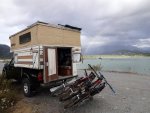You can make a small truck handle the load safely too... Maybe not legally (in all states) but it sounds like in WA and OR you can rerate GVWR based on approval of modifications.
If you did a burly SAS in a new tacoma, reinforced the frame and put heavier suspension on it, it would work. But you would also be more into the modifications than you would be to just buy a diesel truck.
I care about this topic because I have gone through all of this myself. I bought a 1998 tacoma to build my own custom camper on, and planned on frame reinforcements, custom front and rear suspension, and by the time all is said and done the numbers didn't add up.
I now have a 2001 F-350 I bought from the forum here, and it is rated to carry almost 4k, which is sufficient for what I want to do. I drove it from North Carolina to bozeman last weekend and got about 17mpg with 1200# in the bed. It is huge. But at the same time, I think it would probably go anywhere I would take a tacoma with a hard sided camper anyway. I dont plan on crawling with a camper on, but getting to good fishing holes and going up in the mountains will definitely be possible.
If you did a burly SAS in a new tacoma, reinforced the frame and put heavier suspension on it, it would work. But you would also be more into the modifications than you would be to just buy a diesel truck.
I care about this topic because I have gone through all of this myself. I bought a 1998 tacoma to build my own custom camper on, and planned on frame reinforcements, custom front and rear suspension, and by the time all is said and done the numbers didn't add up.
I now have a 2001 F-350 I bought from the forum here, and it is rated to carry almost 4k, which is sufficient for what I want to do. I drove it from North Carolina to bozeman last weekend and got about 17mpg with 1200# in the bed. It is huge. But at the same time, I think it would probably go anywhere I would take a tacoma with a hard sided camper anyway. I dont plan on crawling with a camper on, but getting to good fishing holes and going up in the mountains will definitely be possible.


